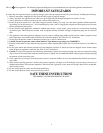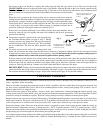
8
5. Pouring water into a dry overheated canner may crack the metal.
6. Do not strike the rim of the canner body with any cooking utensil as this will cause nicks which may damage the rim and
allow steam to escape.
7. When your pressure canner is not in use, invert the cover on the canner body and store in a dry place. Storing the canner with
the cover locked on may cause unpleasant odors and deform the sealing ring.
8.
To ensure safe operation and satisfactory performance, replace the overpressure plug every time you replace the sealing
ring or sooner if it becomes hard, deformed, cracked, worn, or pitted. Replace the sealing ring and overpressure plug at least
every three years. Failure to follow these instructions could result in bodily injury or property damage.
9. If the canner body or cover handles become loose, tighten with a screwdriver.
10. If leakage of moisture or steam develops while using your canner, check the following possible causes:
The formation of a small amount of moisture under the pressure regulator is normal when cooking or canning first begins.
This condensation is a result of the temperature of the pressure regulator being lower than the rest of the canner. If excess
condensation continues, the vent pipe may be loose and should be tightened with an adjustable wrench.
Leakage between the cover and body is usually caused by shrinkage of the sealing ring after prolonged use. Replace the
sealing ring and overpressure plug.
A slight amount of leakage around the air vent/cover lock is normal when canning or cooking first begins. If leakage
continues, the cover handles may not be fully aligned with the body handles and, therefore, the cover lock cannot engage
(see page 5). Clean the air vent/cover lock occasionally to assure that it operates correctly (see page 4). Replace the small
gasket if cracked or nicked.
A small amount of steam or moisture may be visible around the overpressure plug as canning or cooking begins.
This will stop when the overpressure plug seals. If leakage continues, clean or replace the overpressure plug (see
page 7).
Do not operate your pressure canner with continual leakage. If the preceding steps do not correct the problem, return the entire
unit to the Presto Factory Service Department (see page 35).
11. If the pressure canner becomes difficult to open or close, replace the sealing ring.
12.
IMPORTANT: The sealing ring, overpressure plug, and rubber gasket of the air vent/cover lock may shrink, become hard,
deformed, cracked, worn, or pitted with normal use. Exposure to high heat, such as a warm burner or oven top, will cause
these parts to deteriorate rapidly. When this happens, replace the sealing ring, overpressure plug, and small rubber gasket of
the air vent/cover lock. Replace the sealing ring and overpressure plug at least every three years.
Before inserting a new sealing ring, clean the sealing ring groove with a brush. To insure safe operation of your pressure
canner, it is recommended that the overpressure plug be replaced whenever the sealing ring is replaced.
Any maintenance required for this product, other than normal household care and cleaning, should be performed by the Presto
Factory Service Department (see page 35).
PRessuRe CanninG fRuiTs and ToMaToes
Fruits and tomatoes may be processed using pressure canning or boiling water canning. The pressure processing method for fruits and
tomatoes gives a heat treatment equivalent to the much longer processing time required with the boiling water canning method.
Select firm, fully-ripened but not soft fruit or tomatoes. Do not can overripe foods. Some fruits tend to darken while they are being pre-
pared. To prevent the darkening, place fruit in an ascorbic acid solution (1 teaspoon ascorbic acid to 1 gallon water) or use ascorbic acid
or citric acid mixtures according to package instructions.
Although fruit has better color, shape, and flavor when it is canned with sugar, it may be canned unsweetened if desired. White sugar is
preferable to brown sugar for canning. Light corn syrup or honey may be used to replace up to one-half the sugar.
The amount of sugar desirable to use in preparing syrups will depend upon the tartness of the fruit and on family preference. It should be
remembered that fruit, when heated, releases some of its juices which will dilute the syrup in proportion to the juiciness of the fruit.


















